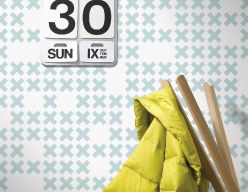Wallpapers material
Design is not the only decisive factor when you are buying the wallpaper. Wallpapers are made of different materials, with different properties or application process. Each material has its advantages and disadvantages and it is good to know what they are. The correct choice of material can prevent disappointment from choosing a material unsuitable for the given space. Our list is not exhaustive, but it will give you the basic idea.

Vlies (non-woven)
Vlies wallpaper material (read as in “fleece”) is relatively new on the market. Yet it had quickly gained fans, mainly thanks to the range of outstanding features it now ranks as Nr 1 at the imaginary wallpaper materials chart. Its main advantages are the air and vapour permeability (the wall beneath is protected from mildew growth) firmness and light fastness. It is an excellent heat and sound insulation. It remains dimensional stability. It is suitable for all rooms. Working with it is easier than with other types of wallpaper. The adhesive is applied just below it, on the wall – so called dry application. It is removed also with dry-stripping and thanks to its firmness also evenly and completely. Vlies wallpaper is also sometimes labeled as "non-woven". It is are made from non-wovens – pulp (cellulose) and synthetic (vinyl) fibers pressed together.
Paper
Wall hangings printed on paper can be single-layered or for better quality as double-layered (so-called duplex). Its biggest advantage is the lower price. Paper wallpaper is however non-washable and of all wallpapers least resistant to scratching. The material is suitable for all interiors. If you opt for paper wall hangings, get ready for a challenging and difficult application. The wallpaper must be soaked before application, therefore the adhesive is applied directly to the wallpaper. Then it is necessary to wait a few minutes until the wallpaper absorbs the glue, but that can change its dimensions.
Vinyl (PVC)
Vinyl wallpaper is popular because of the very high durability and easy maintenance. It is produce dby applying the vinyl layer to the paper base. The quality and durability of wallpaper is determined precisely by the applied vinyl layer. The more layers, the more resilient and better the wallpaper. But the paper backing carries the same properties as the paper wall hangings material. It means more difficult process of application and removal. Indisputable advantage of vinyl wallpaper is the already mentioned resistance, high washability level, color fastness, scratch protection or partial thermal insulation. It can be applied to various surfaces, e. g. plaster, concrete, drywall or formica. It has a very good ability to cover cracks and small bumps. However, it still remains plastic (PVC). It is therefore unsuitable for bedrooms and children's rooms. Some vinyl wallpapers can even release unpleasant odour of plastic, and it is utterly un-permeable.
Recoatable
Recoatable wallpapers are sold in white and is intended as a basis for painting. They are often made from durable non-woven vlies to withstand multiple layers of paint. Paintable wallpapers feature various surface structures. They can imitate wood, stucco, often with geometric patterns. Their advantages and disadvantages are mentioned at vlies wallpaper section.
Fabric
Fabric wallpaper is stylish, more suitable for luxurious spaces. This is reflected in its price. It is heavy and therefore excellent as a thermal and sound proofing. Its further advantage is that it retains its dimensions. You can find various kinds of textile wall hangings on the market, some with a thin vinyl layer, others made from textiles applied to a non-woven vlies base. Those with vlies base are ecologically safe, but they are more demanding for maintenance.

Jan Slovák
jan@lavmi.cz
Other articles

How to calculate the amount of wallpaper I will need?

A short history of wallpaper and other curiosities


 Video tutorial How to paste non-woven wallpaper
Video tutorial How to paste non-woven wallpaper
 How to paste non-woven wallpaper
How to paste non-woven wallpaper
